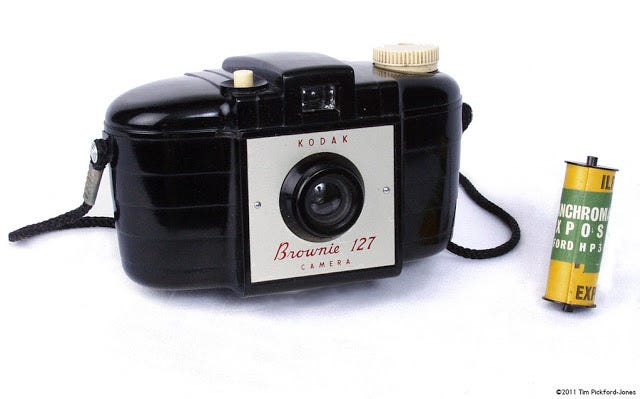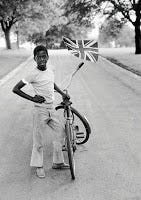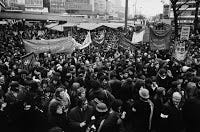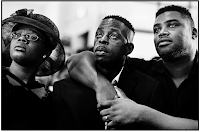Racially Appropriate yet Violently Benign
Gifted a Kodak Brownie 127 from his estranged mother living in London, young Vanley found innocent curiosity in the process of photography…
Gifted a Kodak Brownie 127 from his estranged mother living in London, young Vanley found innocent curiosity in the process of photography whilst still in his homeland Jamaica. Starting from this serendipity, he has now become a key ingredient to black British history. He has spent his life documenting it, so it’s safe to say that there’s a lot we might not know about our past people if not for his work.
Migrating to Handsworth, Birmingham in ’65 as a Windrush child, it’s clear that he grew up with a strong sense of community. In an online interview, he talks about how he would listen to the conversations of shop customers collecting their groceries talk about their disillusionment with England at the time. I find this really interesting because it clearly directed his worldview. He became hyperaware of the negative representation of black people in mainstream press. With war brewing around the world between various groups of people of colour: the Biafran war; the Congo Crisis; the Kashmir conflict; the liberation struggle in South Africa, this aspiring photographer found influence from all corners of the earth. He wanted to rewrite history. Given his position, he was a man caught in a time where archiving was vital. He had the tools for the job so accepted the role wholeheartedly. Because of this, his work can be summarised as the history of Handsworth Birmingham.
His style:
To really digest the style and process of a photographer it’s important to understand their reasons for taking that photo. In this case, the short introduction above worked to do just this. For instance, take the image below:
Vanley talks about how busy these community hairdressers were. Cluttered with goods and filled with life and people. With this in mind, and keeping the fact that his aim is to tell an honest narrative of black British history, it’s clear to see why a shot like this works. The photo has a sharp depth of field. He does this bu making sure the alcove of the room is aligned with the photo frame. Two subjects have also been kept at the edges of the shot both at varying depth to add dimension to an otherwise flat image. Centred in all this clutter, the attention of the viewer is directed to a customer mid-treatment. This clarity in composition has been done in a near sea of stuff.
Having Vanley attend our event is our opportunity to learn about his process. There are aspects to his work that are universal to photography and others more unique to his style and flavour. It’s also important to note that he refrains from naming his photos since that limits the artistic expression that comes from the artwork itself. With a name comes a directed train of thought. That being said, in his own words some photos lend themselves to names.
Aligning The Frame
A key feature in his photos is his ability to coordinate the extension of lines. Be it from the frame or from within the shot. He uses this in various ways. In the image above, he wants to highlight the depth in the photo so it’s really important to coordinate the lines in a way that preserves the enclosure of the room. Whilst in the image to the left, he need only focus the attention of the viewer on the boy, subsequently he aligns the horizon with the boy’s head so as not to distract. You can see this feature in a number of his works.
Crowds
In his works, you’ll notice a large collection of crowds, Vanley often shot protests and subsequent crowds. During our event, he discussed how he was a good climber as a child in Jamaica. He’d climb tall trees to pick fruit or just watch the world go by. This childhood innocence persists even in adulthood because, in order to compress large crowds into a single frame, the photographer must ascend to great heights. Vanley did just this, the results speak for themselves.
Subject Relationship and Building Rapport
Social documenting as a style of photography aims to authenticate the visual narrative of a community of people. After all, the birth of Vanley’s career comes from his desire to challenge the mainstream representation of black people in the media. Because of this need, it’s vital to build rapport with your subjects and to maintain your relationship over the years. Centred in the photo on the left is Wilfred — the ‘Boy with flag’ after several years. This is a powerful feature of Vanley’s work, his ability to build such a strong and long-lasting relationship with his subjects. By doing this, he is able to remain as he puts it the fly on the wall.
These techniques and approaches are those specific to a style of social documenting, and more so to Vanley as a photographer. What stood out to me is the balance between technical know-how and your ability to build a connection with your subjects.
So, why the title? Having spent some time with Vanley in planning the event, it’s that he is more than a photographer. He exudes creativity, further, he exudes creativity to highlight racial tensions. From the Slave ship made from seashells in the Gambia, to the transformation of spaces to demonstrate Caribbean migration and settlements, as well as just turning his entire home into a museum. In this sense, his work is racially appropriate. Further adding on to this, he is able to inject his artistic expression into any domain whilst still remaining innocent and sincere — this is what I mean by violently benign. At no point has his work given up on what he stands for nor does it aim to hurt a disparate soul. Therefore, his work is racially appropriate yet violently benign.








